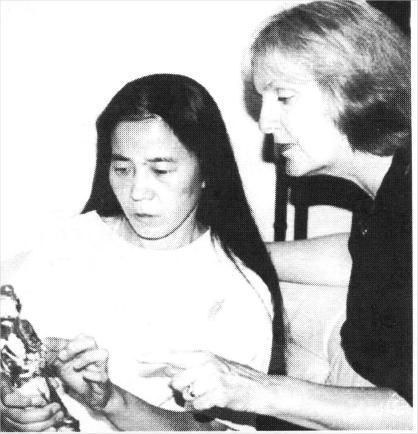From Asia, With Love
by Georgia G. Otten
Issue 306 - October 1998
Just where do we find information about Cambridge glass? There are books which address many glass companies and their patterns. There are the "Cambridge" books and the Crystal Ball. There are conventions and study clubs where much is shared. And then there is the chance encounter. One never knows when or who will bring us new insight.
 Mac and I have a new member in
our family. Her name is Yan Hui and she is from Beijing China. In June
1997 she became the bride of Mac’s son, Scott. They currently
reside in Maryland but were in Dayton with us last Christmas. Christmas
is the "when" of this story and Yan Hui is the "who."
Mac and I have a new member in
our family. Her name is Yan Hui and she is from Beijing China. In June
1997 she became the bride of Mac’s son, Scott. They currently
reside in Maryland but were in Dayton with us last Christmas. Christmas
is the "when" of this story and Yan Hui is the "who."
It is safe to say that Yan Hui knows only the obvious about Cambridge glass: it's BEAUTIFUL. What a special time we had looking at different pieces. As we looked at the flower arrangers, I was most eager to show her our crystal "One Bun" and told her we called the figure "Geisha." Yan Hui very politely informed me. "Is no geisha." And she continued. "Is no Japanese hair," encircling the top of the head with her finger. "Is no Japanese sleeve," waving her hand over the figure's garment. I opted for correction to call the figure "Asian." Then thought I had an opportunity here. If not a Japanese style, is it Chinese? I had read an article in a back issue of the Crystal Ball on the "One Bun," "Two Bun' names. An idea was perhaps one figure was male and the other female. Or, if both figures were women, the hair style was an individual choice. Apparently there was no known significance. Ah, but there is significance to the hairstyles: Chinese significance! Not owning a "Two Bun" figure, I used the Colors in Cambridge Glass for a picture to show Yan Hui and asked about the hair. Now, new insight. After a little trouble with our terms "one bun." "two bun," which Yan Hui found funny, she explained. In Chinese history, a woman wearing hair gathered in a "One bun" style, would indicate a lady of means or higher social standing. The "two bun" style would designate a woman from the working class, perhaps a domestic or personal Servant.
After Christmas I went to the library and looked up books on world costume, Chinese art, and the Japanese kimono. The pictures I found support the hair and the costume contrast between Japanese and Chinese styles. I also saw pictures that supported the two classes. In one Chinese art book, a Chinese lady was being served, perhaps tea, and she had the "one bun" gathered up hair style and the young lady serving had the "two bun" style. A second girl in attendance, standing nearby, was holding what appeared to be a fan. That second girl also donned the "two bun" style. For additional support, I called two Chinese restaurants in our area. Both ladies I talked with confirmed these hairstyle traditions from Chinese history.
According to the dictionary, geisha is: "a Japanese girl trained as a professional singer, dancer, and companion for men." Our Cambridge figure appears significantly more a Chinese style than Japanese style. It is not documented, as far as I know, that the term "geisha' was a Cambridge designation. I would be inclined to believe it was an advertising term, not to be taken literally, but rather to garner interest, as the Asian influence in decorating was quite popular at the time the figures were first introduced in the 1920s.
Talking "Cambridge" is consistently a delight to us glass collectors, and new information is always very exciting. So make sure you are listening, because information flows freely and it may come to you,
From Asia, With Love
